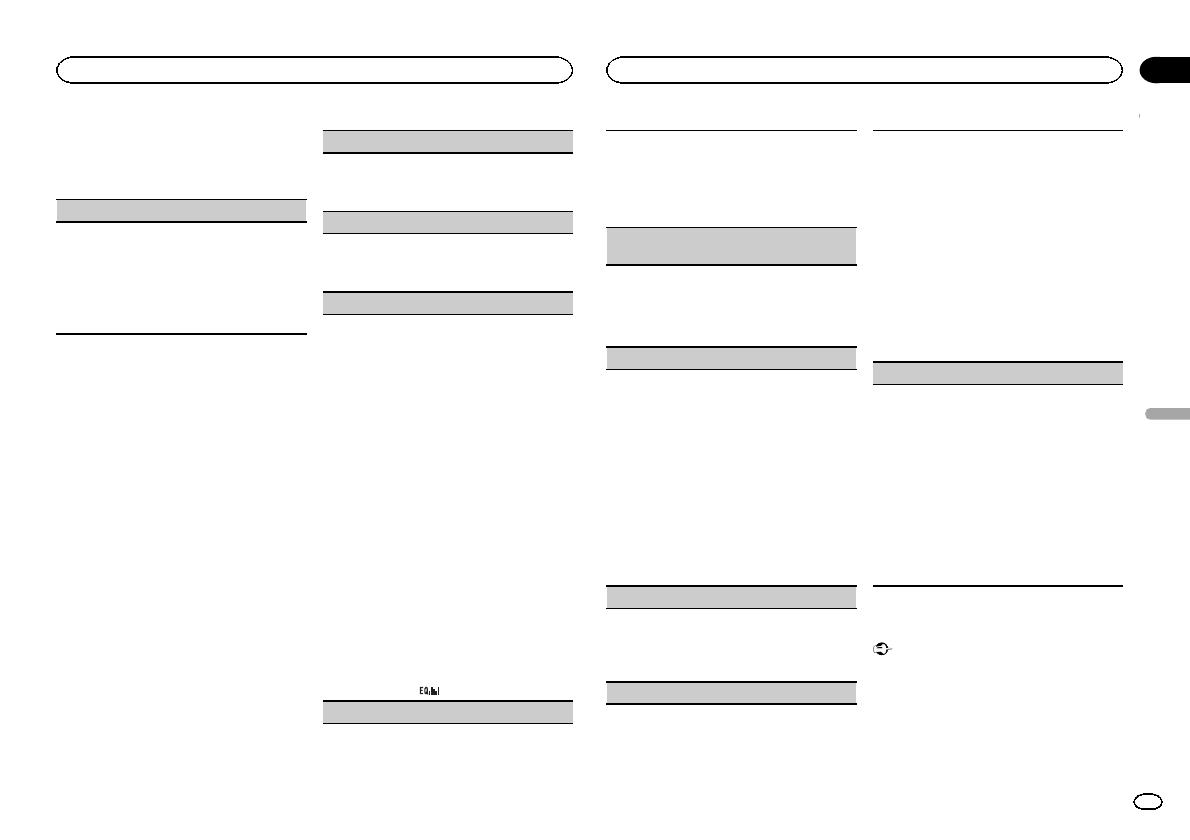
2 Gire M.C. para cambiar la opción de
menú y pulse para seleccionar FUNCTION.
Una vez seleccionado, se puede ajustar la fun-
ción de abajo.
S.RTRV (recuperador de sonido)
Mejora automáticamente el audio comprimido y
restaura el sonido óptimo.
1 Pulse M.C. para seleccionar el ajuste deseado.
Para obtener más información, consulte Mejo-
ra del audio comprimido y restauración del soni-
do óptimo (Sound Retriever) en la página
anterior.
Ajustes de audio
1 Pulse M.C. para acceder al menú princi-
pal.
2 Gire M.C. para cambiar la opción de
menú y pulse para seleccionar AUDIO.
3 Gire M.C. para seleccionar la función de
audio.
Una vez seleccionado, se pueden ajustar las si-
guientes funciones de audio.
! FADER no está disponible cuando se selec-
ciona SUB.W/SUB.W en SP-P/O MODE. Para
más información, consulte SP-P/O MODE
(ajuste de la salida posterior y del preamplifica-
dor) en la página siguiente.
! SUB.W, SUB.W CTRL, HPF SETTING no están
disponibles cuando se selecciona
REAR/REAR en SP-P/O MODE. Para más in-
formación, consulte SP-P/O MODE (ajuste de
la salida posterior y del preamplificador) en la
página siguiente.
! SUB.W CTRL y HPF SETTING no están dispo-
nibles cuando se selecciona SUB.W en OFF.
Para más información, consulte SUB.W
(ajuste de subgraves activado/desactivado) en
esta página.
FADER (ajuste de ecualizador)
1 Pulse M.C. para mostrar el modo de ajuste.
2 Gire M.C. para ajustar el balance entre los alta-
voces delanteros/traseros.
BALANCE (ajuste del balance)
1 Pulse M.C. para mostrar el modo de ajuste.
2 Gire M.C. para ajustar el balance de los altavo-
ces izquierdo o derecho.
EQ SETTING (recuperación de ecualizador)
1 Pulse M.C. para mostrar el modo de ajuste.
2 Gire M.C. para seleccionar el ecualizador.
POWERFUL—NATURAL—VOCAL—CUS-
TOM1—CUSTOM2—FLAT—SUPER BASS
La banda y el nivel de ecualización se pueden
personalizar si se selecciona CUSTOM1 o
CUSTOM2.
Si selecciona CUSTOM1 o CUSTOM2, com-
plete los pasos que se describen más abajo. Si
selecciona otras opciones, pulse M.C. para
volver a la pantalla anterior.
! CUSTOM1 puede ajustarse por separado
para cada fuente.
! CUSTOM2 es una configuración comparti-
da que se utiliza para todas las fuentes.
3 Pulse M.C. para mostrar el modo de ajuste.
4 Pulse M.C. para desplazarse entre las siguien-
tes opciones:
Banda de ecualización—Nivel de ecualización
5 Gire M.C. para seleccionar el ajuste deseado.
Banda de ecualización: 80HZ—250HZ—
800HZ—2.5KHZ—8KHZ
Nivel de ecualización: +6 a –6
! También puede cambiar el ecualizador pulsan-
do varias veces
.
LOUDNESS (sonoridad)
La sonoridad compensa las deficiencias en los in-
tervalos de frecuencias bajas y altas cuando se es-
cucha a un volumen bajo.
1 Pulse M.C. para seleccionar el ajuste deseado.
OFF (desactivado)—LOW (bajo)—MID
(medio)—HI (alto)
SUB.W (ajuste de subgraves activado/desactiva-
do)
Esta unidad está equipada con una salida de sub-
graves que se puede activar o desactivar.
1 Pulse M.C. para seleccionar el ajuste deseado.
NOR (fase normal)—REV (fase inversa)—OFF
(subgraves desactivados)
SUB.W CTRL (ajuste de subgraves)
Solo las frecuencias más bajas que aquellas en el
intervalo seleccionado se generan por el altavoz
de subgraves.
1 Pulse M.C. para mostrar el modo de ajuste.
2 Pulse M.C. para desplazarse entre las siguien-
tes opciones:
Frecuencia de corte—Nivel de salida—Nivel de
pendiente
Las tasas que se puedan ajustar parpadearán.
3 Gire M.C. para seleccionar el ajuste deseado.
Frecuencia de corte: 50HZ—63HZ—80HZ—
100HZ—125HZ—160HZ—200HZ
Nivel de salida: de –24 a +6
Nivel de pendiente: –6— –12
BASS BOOST (intensificación de graves)
1 Pulse M.C. para mostrar el modo de ajuste.
2 Gire M.C. para seleccionar el nivel que desee.
Se visualiza 0 a +6 mientras se aumenta o dis-
minuye el nivel.
HPF SETTING (ajuste del filtro de paso alto)
Cuando no desee que se generen los sonidos
bajos del intervalo de frecuencias de salida de
subgraves a través de los altavoces delanteros o
traseros, active el filtro de paso alto (HPF). Solo
las frecuencias más altas que aquellas del interva-
lo seleccionado se generan a través de los altavo-
ces delanteros o traseros.
1 Pulse M.C. para mostrar el modo de ajuste.
2 Pulse M.C. para desplazarse entre las siguien-
tes opciones:
Frecuencia de corte—Nivel de pendiente
3 Gire M.C. para seleccionar el ajuste deseado.
Frecuencia de corte: OFF—50HZ—63HZ—
80HZ—100HZ—125HZ—160HZ—200HZ
Nivel de pendiente: –6— –12
SLA (ajuste del nivel de fuente)
SLA (ajuste del nivel de fuente) le permite ajustar
el nivel de volumen de cada fuente para evitar
cambios radicales en el volumen cuando se cam-
bia entre las fuentes.
! Los ajustes se basan en el nivel de volumen de
FM, que se mantiene inalterado.
! El nivel del volumen de MW/LW también se
puede ajustar con esta función.
! Al seleccionar FM como fuente, no se podrá
cambiar a SLA.
1 Pulse M.C. para mostrar el modo de ajuste.
2 Gire M.C. para ajustar el volumen de la fuente.
Gama de ajuste: de +4 a –4
Menú del sistema
Importante
PW SAVE (ahorro de energía) se cancela si la
batería del vehículo se desconecta, y se debe ac-
tivar de nuevo cuando se vuelva a conectar la
batería. Dependiendo de los métodos de cone-
xión, cuando PW SAVE (ahorro de energía) está
desactivado, la unidad puede seguir obteniendo
energía de la batería si la llave de encendido de
su vehículo no tiene posición ACC (accesorio).
Español
Utilización de esta unidad
53
Sección
Utilización de esta unidad
Es
02











































































































